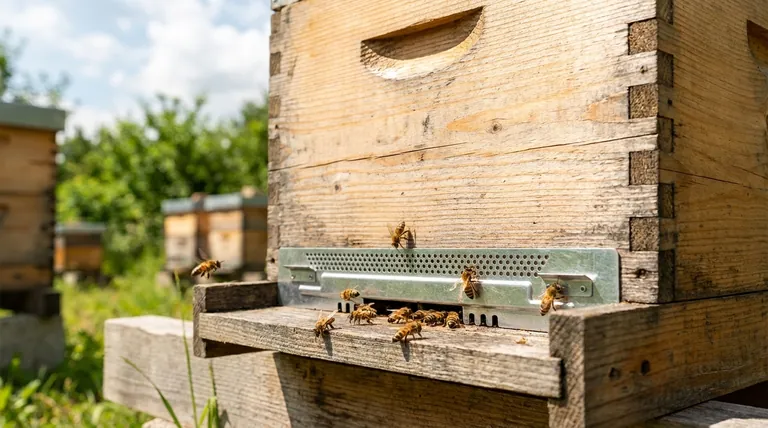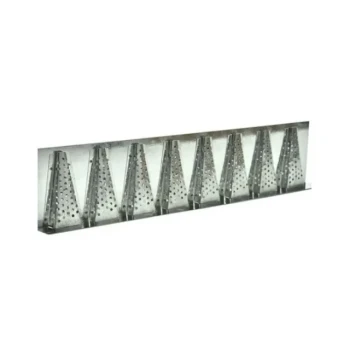To be clear, an entrance reducer can be used during any season, but its purpose and configuration must change to match the colony's needs. It is not a "set it and forget it" tool; its use is dictated by temperature, colony size, and external threats, which vary throughout the year.
The core principle is not to follow a rigid calendar, but to adapt the hive entrance to the colony's current strength and the immediate environmental conditions. The reducer is a tool to manage defense, temperature, and ventilation—each of which is critical at different times.

The Core Functions of an Entrance Reducer
A simple block of wood may seem insignificant, but it serves three distinct and vital purposes for the health and productivity of a honey bee colony.
Regulating Temperature
In the cold of winter, a wide-open entrance allows precious heat to escape. Using the reducer's smallest opening minimizes this heat loss, helping the winter cluster consume less honey to stay warm.
This also prevents pests like mice from entering the hive to seek warmth and food.
Enhancing Hive Defense
A small colony, a newly installed package, or a weaker hive has fewer guard bees. A large, open entrance is a significant defensive liability they cannot manage.
By reducing the entrance size, you create a defensible chokepoint. This allows a small force of guard bees to effectively repel robbing bees from other hives, as well as wasps and hornets.
Managing Ventilation and Traffic
Conversely, a large, populous colony in the heat of summer needs maximum ventilation. Bees fan their wings at the entrance to draw in cool air and evaporate moisture from nectar to cure it into honey.
A fully open entrance is crucial for this process. It prevents the hive from overheating and eliminates traffic jams during a heavy nectar flow, allowing foragers to work at maximum efficiency.
A Situational Guide: When and How to Use It
Instead of thinking in terms of seasons, it is more effective to think in terms of the hive's specific situation.
For Winter Survival
During the coldest months, the primary goal is heat conservation.
Turn the reducer to the smallest notch. This provides a minimal entrance for cleansing flights on warm days while keeping the colony protected from cold drafts and pests.
For Spring and Fall Management
These are transitional seasons. The colony is either building up (spring) or shrinking (fall), and temperatures can fluctuate wildly.
Use the larger notch during these times. It provides a balance, offering some defensive help while still allowing adequate access for a growing number of foragers. This is especially important for new hives installed in the spring.
For Peak Summer and Nectar Flow
For a strong, established colony, the goal in summer is productivity and temperature control.
Remove the reducer entirely. The colony needs a wide, open entrance to handle the heavy two-way traffic of foragers and to provide the ventilation necessary to cool the hive and cure honey.
Understanding the Critical Trade-offs
Improper use of an entrance reducer can cause more harm than good. A beekeeper's biggest mistake is failing to adapt to the colony's changing needs.
The Risk of Overheating
Leaving an entrance reducer on during hot weather is a serious danger. The colony cannot effectively ventilate, which can lead to the bees "bearding" on the outside of the hive, reduced productivity, and in extreme cases, melting wax and colony death.
The Problem of Traffic Jams
For a strong hive during a nectar flow, a reduced entrance creates a bottleneck. This slows down foragers, reduces the amount of nectar coming in, and ultimately limits your honey harvest.
The Importance of Observation
Do not rely on the calendar alone. A good rule of thumb is to observe the bees and the weather. If it's warm enough for you to be comfortable in a light sweater, a strong hive likely does not need its entrance reduced.
Making the Right Choice for Your Colony
Your decision should always be based on the specific state of your hive.
- If you have a new or weak colony: Use the reducer (medium or small notch depending on temperature) to help them defend their home until the population grows strong.
- If you have a strong, established colony: Use the smallest notch only during deep winter and remove it completely for summer to maximize ventilation and productivity.
- If your area has high robbing pressure: Consider using the medium notch in late summer or fall, even on a strong hive, when nectar is scarce and robbing is common.
Ultimately, observing your bees and understanding their needs is the most important skill in beekeeping.
Summary Table:
| Situation | Recommended Entrance Reducer Setting | Primary Goal |
|---|---|---|
| Winter Survival | Smallest Notch | Conserve heat, prevent pests |
| Spring/Fall Transition | Larger Notch | Balance defense & forager traffic |
| Peak Summer / Nectar Flow | Removed Completely | Maximize ventilation & productivity |
| New or Weak Colony | Medium/Small Notch | Aid in hive defense |
Equip Your Apiary with Precision Beekeeping Tools from HONESTBEE
Managing your hives effectively requires the right equipment for the right season. At HONESTBEE, we supply commercial apiaries and beekeeping equipment distributors with high-quality, durable entrance reducers and other essential supplies through our wholesale-focused operations.
Let us help you build a stronger, more productive operation. Contact our team today to discuss your wholesale needs and ensure your colonies thrive year-round.
Visual Guide

Related Products
- Beehive Entrance Reducer Guardian Metal Hive Entrance for Bees
- Multi-Functional Sliding Hive Entrance for Beekeeping
- Multi-Functional Rotary Hive Entrance Disc for Beekeeping
- Steel Round Disc Entrance Reducer for Flexzion Bee Hive Nuc Box Gate
- Beehive Entrance Discs Plastic Bee Entrance Disc for Bee Hives
People Also Ask
- What is the purpose of placing an object in front of the hive entrance after a move? A Guide to Forced Reorientation
- How can a Langstroth hive entrance be adjusted? Mimic Natural Bee Preferences for a Healthier Hive
- What are the different entrance sizes for an 8 or 10-frame Langstroth hive? A Guide to Seasonal Management
- What size is the entrance hole in a native bee hive? The 13mm Standard for a Thriving Colony
- How big should a beehive entrance be? Optimize for Colony Health & Honey Production



















